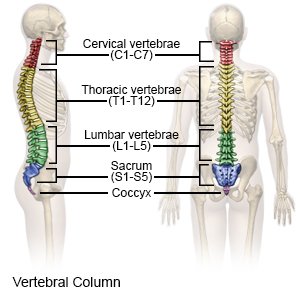Cervical Spinal Stenosis
Medically reviewed by Drugs.com. Last updated on Aug 4, 2025.
Cervical spinal stenosis is narrowing of the spinal canal in your neck. Your spinal canal holds your spinal cord. When your spinal canal narrows, it may put pressure on your spinal cord. Cervical spinal stenosis is a chronic (long-term) condition.
 |
DISCHARGE INSTRUCTIONS:
Return to the emergency department if:
- You injure your neck, and your pain and symptoms worsen.
- You have new or increased trouble walking.
- You cannot control when you urinate or have a bowel movement.
- You have more numbness, tingling, or weakness than before.
Contact your healthcare provider if:
- Your pain does not get better or gets worse, even after you take medicines.
- You have questions or concerns about your condition or care.
Medicines:
You may need any of the following:
- NSAIDs , such as ibuprofen, help decrease swelling and pain. NSAIDs can cause stomach bleeding or kidney problems in certain people. If you take blood thinner medicine, always ask your healthcare provider if NSAIDs are safe for you. Always read the medicine label and follow directions.
- Acetaminophen decreases pain and fever. It is available without a doctor's order. Ask how much to take and how often to take it. Follow directions. Read the labels of all other medicines you are using to see if they also contain acetaminophen, or ask your doctor or pharmacist. Acetaminophen can cause liver damage if not taken correctly.
- Prescription pain medicine may be given. Ask how to take this medicine safely.
- Muscle relaxers help decrease pain and muscle spasms.
- Take your medicine as directed. Contact your healthcare provider if you think your medicine is not helping or if you have side effects. Tell your provider if you are allergic to any medicine. Keep a list of the medicines, vitamins, and herbs you take. Include the amounts, and when and why you take them. Bring the list or the pill bottles to follow-up visits. Carry your medicine list with you in case of an emergency.
Manage your symptoms:
- Go to physical and occupational therapy as directed. A physical therapist teaches you exercises to help improve movement and strength, and to decrease pain. An occupational therapist teaches you skills to help with your daily activities.
- Apply heat on your neck for 20 to 30 minutes every 2 hours for as many days as directed. Heat helps decrease pain and muscle spasms.
- Apply ice on your neck for 15 to 20 minutes every hour or as directed. Use an ice pack, or put crushed ice in a plastic bag. Cover it with a towel before you apply it to your skin. Ice helps prevent tissue damage and decreases swelling and pain.
- Avoid certain activities. Some activities may worsen your condition or cause more injury. Do not ride motorcycles or horses, climb ladders, or play football or other contact sports. Ask your provider which activities you should avoid.
Follow up with your healthcare provider as directed:
Write down your questions so you remember to ask them during your visits.
© Copyright Merative 2025 Information is for End User's use only and may not be sold, redistributed or otherwise used for commercial purposes.
The above information is an educational aid only. It is not intended as medical advice for individual conditions or treatments. Talk to your doctor, nurse or pharmacist before following any medical regimen to see if it is safe and effective for you.
Further information
Always consult your healthcare provider to ensure the information displayed on this page applies to your personal circumstances.
